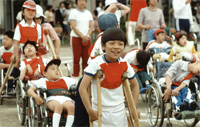
Over 650 million people in the world have a disability; they make up approximately 10% of the world’s population and are the world’s largest minority. According to UNDP, around 80% of persons with disabilities live in developing countries. Worldwide trends, including the combination of population growth, population ageing and medical advances mean this group continues to grow.
The commitment of the United Nations to the rights of persons with disabilities was codified into an international human rights convention in 2006. The Millennium Development Goals (MDGs), adopted in 2000, call on all stakeholders to take action towards achieving eight key developmental goals by 2015. The goals focus on reducing extreme poverty, improving health and education and environmental sustainability to improve the lives of the world’s poorest populations. The Goals are also an expression of fundamental human rights, encompassing universally accepted human values and rights for all.
Although the MDGs do not currently make any specific mention of disability, the United Nations has since reiterated the commitment of the international community to promote the inclusion of disability in Millennium Development Goal processes where persons with disabilities are both development agents and beneficiaries.
The International Day of Persons with Disabilities
In this context, the theme of the 2010 United Nations’ International Day of Persons with a Disability, celebrated annually on 3 December, is “Keeping the promise: Mainstreaming disability in the Millennium Development Goals towards 2015 and beyond”.
The Day aims to promote a better understanding of disability issues with a focus on the rights of persons with disabilities and the gains to be derived from the integration of persons with disabilities in every aspect of the political, social, economic and cultural life of their communities. Events will be held worldwide to commemorate the Day with a particular focus on ways to ensure that society and governments will make the MDGs more inclusive and will promote development for all.
Mainstreaming disability in the MDGs
The MDG country reports provided a mixed picture suggesting some progress in mainstreaming disability in development in the context of theMDGs, but also raised concerns that disability remains largely “invisible” in the national development priorities. Despite recent progress, comparative studies on disability legislation show that only 45 countries have anti-discrimination and other disability-specific laws.
In addition, there remain significant gaps between policy and implementation. Persons with disabilities often face complex, multifaceted and multi-layered challenges. In addition to the difficulties stemming from the disability itself, issues such as poverty and gender discrimination may further hinder their integration into society.
In support of efforts by Governments and civil society to achieve the Goals, at the global, regional and country levels, the United Nations works in four activity areas: monitoring; analysis; awareness-raising campaigning and mobilization; and operational activities.
The Inter-Agency and Expert Group on MDG Indicators undertakes analysis to monitor progress towards realization of the Goals at the global and regional levels, which plays an important role for inclusion of disability in all MDG processes.
The impact of the multiple crises
Recently, successive crises have hit the world and contributed to a slowing in development progress in general. The United Nations have urged Member States not to use lack of resources as an excuse for failing to meet their targets. The organization has also called on numerous occasions for pro-poor policies to be implemented along with protection measures to ensure those with the least are not disproportionately affected.
However, cuts in public spending announced by many developed countries could lead to decrease in health and social services and the reduction or cutting of benefits and allowances and these fiscal austerity measures are especially likely to affect people with disabilities.
Furthermore, analysis of food crisis suggests that the underlying problem is one of poverty more than scarcity of food and people with disabilities are among those most at risk of being unable to afford to eat. In turn, malnourishment in itself increases the risk of members of affected populations developing disabilities in the first place.
With regard to natural disasters, including those climate change causes, the poorest and most vulnerable often suffer a disproportionately negative impact and persons with disabilities are at risk of becoming ‘invisible’ and excluded from relief efforts. In addition, these disasters can cause debilitating injuries and illnesses which then leave many people with long term disabilities.
Similarly, wars and conflicts remain not only a major cause of disabilities, but also leave persons with disabilities exceptionally vulnerable, through loss of care givers and poor access to aid and relief efforts. The United Nations has urged member states to use these crises as opportunities for a ‘fresh start’ – for example, after a natural disaster, a conflict or a recession to rebuild structures that are designed to be accessible to persons with disabilities.
The importance of data and statistics
The General Assembly has called on Governments to build a knowledge base of data and information about the situation of persons with disabilities, which could be used to facilitate disability-sensitive development policy planning, monitoring, evaluation and implementation. Particular attention is paid to the realization of the Millennium Development Goals for persons with disabilities. It has also urged Governments to cooperate and to avail themselves of the technical assistance of the Statistics Division of the Department of Economic and Social Affairs (DESA).
The consensus is that focusing on the inclusion of disability in the current MDG indicators would be more effective in promoting the inclusion of disability data than proposing any new indicators related to disability. This will require identifying those indicators that could be meaningfully disaggregated by disability. Inclusion of disability into the specific Goals could be based on whether the goal is “overarching” and/or the availability of disability disaggregated data. Goals 1, 2 and 3 would meet these two criteria.
However, such an approach has some limitations, as available data may not always be adequate to reflect the relevance or importance of an issue. In such a case, when the scope of data and evidence are limited, efforts to identify additional data could be made to bridge the gap.
Within the United Nations system
The Convention on the Rights of Persons with Disabilities sets out legal obligations on States to promote and protect the rights of persons with disabilities, it does not create new rights. It was adopted on 13 December 2006, and entered into force on 3 May 2008.
The Convention is a legally binding treaty, intended as a human rights instrument with an explicit, social development dimension. It adopts a broad categorization of persons with disabilities and reaffirms that all persons with all types of disabilities must enjoy all human rights and fundamental freedoms.
The Convention reinforces and works in synergy with pre-existing international texts such as the Standard Rules on the Equalization of Opportunities for Persons with Disabilities and the World Programme of Action, neither of which are legally binding treaties.
United Nations Voluntary Fund on Disability provides funding targeted towards building the capacity of non-governmental organizations to take part in the implementation of the Convention on the Rights of Persons with Disabilities. The Fund is administered by the Secretariat for the Convention on the Rights of Persons with Disabilities, within DESA.
For more information: http://www.un.org/disabilities/


